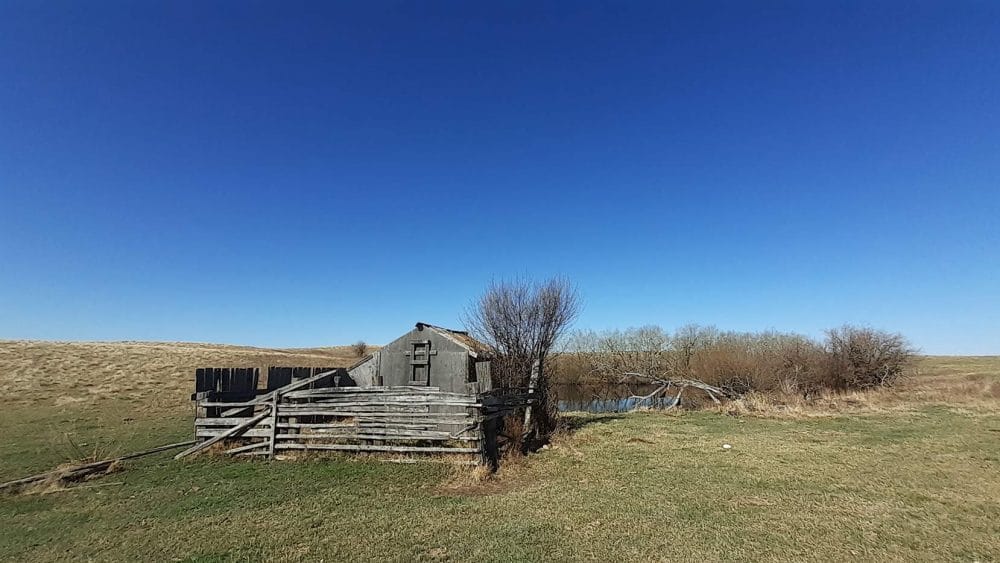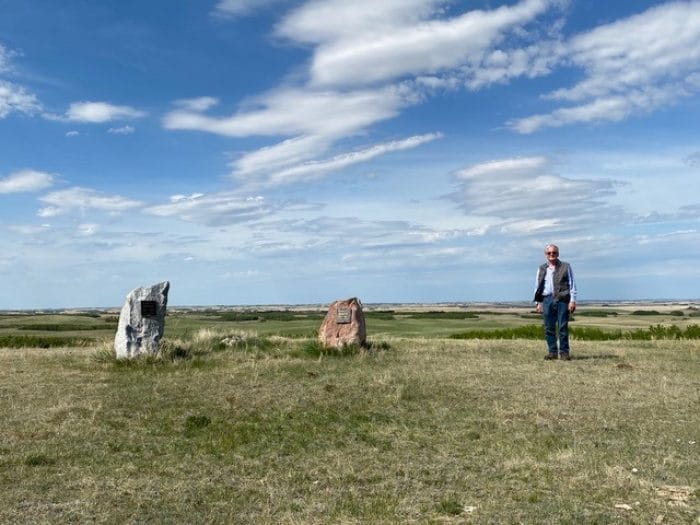Story
December 2, 2020
Saskatchewan farm family’s deep roots anchor conservation ethic
This four-generation farm sits at the confluence of three major migration flyways. Here, potential waterfowl densities for all species combined are estimated at 51-60 pairs per square mile.
It was like stepping onto the set of a movie.
When DUC conservation program specialist, Brooke Forbes, first arrived at the Baker farm, it was as though a behind-the-scenes film director yelled “Cue the moose!” at just the right moment. Out paraded a cow moose, making for a very dramatic introduction to the property for Forbes, and the beginning of a relationship that would see Terry Baker and his family sign up two quarter-sections (320 acres or 129 hectares) of grassland into DUC’s conservation easement program.
A WATERFOWL MECCA
“Brooke can tell you all about the wildlife,” Baker says, beaming. His enthusiasm is evident even over the phone.
As the DUC staff person responsible for delivering our habitat securement program in the North Battleford area, Forbes accompanied the Baker family through the entire conservation easement process. The easement now protects the natural habitat found here in perpetuity. Having toured the property extensively, she echoes Terry’s assessment of the land’s value to wildlife and waterfowl. “These quarters are basically ideal for what we look for in an easement.”
The Baker farm is located in DUC’s Cactus Lake target area in western Saskatchewan, approximately 145 kilometres south of North Battleford. Family holdings include a roughly equal mix of pasture and annual cultivation.
The native prairie and intermingled wetlands of the pasture lands provide a home for many wildlife species. In a region where pasture acres are increasingly being converted to annual cropping, conserving parcels like this is critical.
Along with the perfect mix of perennial cover and water, the Baker conservation easement sits at the confluence of three major migration flyways, making it a waterfowl lover’s mecca.
According to DUC’s waterfowl productivity research, the Baker property falls within a significant area where potential waterfowl densities for all species combined are estimated at 51-60 pairs per square mile.

A DEPTH OF HISTORY
If the habitat value of these two quarters is extraordinary – and it is – it’s pale in comparison to the deep connection the Baker family has to this land. Four generations of Bakers have worked and played here; it was actively farmed by the family for 112 years.
“The land was homesteaded by my grandfather in the early 1900s, then farmed by my dad. My wife, Nancy, and I moved back to the farm in the 1970s, where we raised our two sons and daughter.” In a remarkable instance of family déjà vu, Baker’s own kids attended the same school as both his father and his sister.
“When Dad passed away in 2002, we knew we wanted to place a memorial on the farm”, Baker confides. Terry’s father had always taken special pride in the grassland and the cattle business, keeping 300 head of cattle when most local operations were one third the size or less.
A memorial site was created in an area of grassland of particular significance to the Baker family. A small ceremony was held during which Baker’s father’s ashes were scattered at the site. Two years later, his father’s half-brother was also celebrated and remembered here. Since then, other family members have expressed interest in this as their someday resting place.

PRESERVING THE PLACE WHERE ROOTS GROW DEEPEST
When Terry and his family were approached by DUC staff about a conservation easement, they knew it was time to preserve the land in perpetuity, with special urgency around protecting the memorial site, and the place where their family roots grew deepest. An easement was the perfect instrument for the Bakers to live out their conservation values while protecting a precious family legacy.
While land like the Baker’s has an obvious history, it also possesses a wisdom for those who listen. Among the careful ones, this collective knowledge is passed down and preserved.
“There was an area next to a wetland that dad farmed in the fifties and sixties but eventually decided to seed to grass to deal with salinity issues. The salinity cleared up, but we never farmed that strip again. That grass is used for hay to this day.” Baker’s dad was before his time in his use of forages for salinity management; Baker himself dreams of one day creating a demonstration site to share family wisdom like this with new generations of students and farmers.
The kind of enduring connection the Bakers have with their land and its inhabitants over the ages is a rare and special gift. Treading on the same soil as one’s ancestors offers the poignant realization that every view you’ve admired has been witnessed by a relative before you, every area of agronomic challenge has had a solution similarly pondered.
In opting to conserve their land today, the Bakers not only protect its ecological and cultural features for future generations, but also carry forward the collective wisdom and values of all those family members who have gone before them.
And that is definitely something to be proud of.
PART OF THE NATURAL HERITAGE CONSERVATION PROGRAM
The conservation easement on the Baker’s farm was funded by the Government of Canada’s Natural Heritage Conservation Program, part of Canada’s Nature Fund. Securing this habitat contributes to the Government’s target of conserving 25 per cent of Canada’s lands by 2025 while enhancing biodiversity and supporting species at risk.
